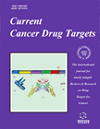- Home
- A-Z Publications
- Current Cancer Drug Targets
- Previous Issues
- Volume 23, Issue 2, 2023
Current Cancer Drug Targets - Volume 23, Issue 2, 2023
Volume 23, Issue 2, 2023
-
-
Characteristic Hallmarks of Aging and the Impact on Carcinogenesis
More LessEvidence shows that there is a synergistic, bidirectional association between cancer and aging with many shared traits. Age itself is a risk factor for the onset of most cancers, while evidence suggests that cancer and its treatments might accelerate aging by causing genotoxic and cytotoxic insults. Aging has been associated with a series of alterations that can be linked to cancer: i) genomic instability caused by DNA damage Read More
-
-
-
RON Receptor Tyrosine Kinase in Tumorigenic Stemness as a Therapeutic Target of Antibody-drug Conjugates for Eradication of Triple-negative Breast Cancer Stem Cells
More LessAuthors: Sreedhar R. Suthe, Hang-Ping Yao, Tian-Hao Weng and Ming-Hai WangBackground: Cancer stem-like cells in triple-negative breast cancer (TNBC-SLCs) are the tumorigenic core for malignancy. Aberrant expression of the RON receptor tyrosine kinase has implications in TNBC tumorigenesis and malignancy. Objective: In this study, we identified the RON receptor as a pathogenic factor contributing to TNBC cell stemness and validated anti-RON antibody-drug conjugate Zt/g4-MMAE for eradication Read More
-
-
-
FA-HA-Amygdalin@Fe2O3 and/or γ-Rays Affecting SIRT1 Regulation of YAP/TAZ-p53 Signaling and Modulates Tumorigenicity of MDA-MB231 or MCF-7 Cancer Cells
More LessBackground: Breast cancer (BC) has a complex and heterogeneous etiology, and the emergence of resistance to conventional chemo-and radiotherapy results in unsatisfactory outcomes during BC treatment. Targeted nanomedicines have tremendous therapeutic potential in BC treatment over their free drug counterparts. Objective: Hence, this study aimed to evaluate the newly fabricated pH-sensitive multifunct Read More
-
-
-
Sildenafil Inhibits the Growth and Epithelial-to-mesenchymal Transition of Cervical Cancer via the TGF-β1/Smad2/3 Pathway
More LessAuthors: Ping Liu, Jing-Jing Pei, Li Li, Jing-Wei Li and Xiao-Ping KeAims: The study aims to explore new potential treatments for cervical cancer. Background: Cervical cancer is the second most common cancer in women, causing >250,000 deaths worldwide. Patients with cervical cancer are mainly treated with platinum compounds, which often cause severe toxic reactions. Furthermore, the long-term use of platinum compounds can reduce the sensitivity of cancer cells to chemotherapy and i Read More
-
-
-
Knockdown of PRKD2 Enhances Chemotherapy Sensitivity in Cervical Cancer via the TP53/CDKN1A Pathway
More LessAuthors: Ruijing Feng, Xin Wang, Hongwei Chen, Chen Cao, Ting Liu, Tong Zhao, Huang Chen, Rui Tian, Yangyang Ni, Xun Tian, Zheng Hu, Ji Ma and Danni GongBackground: Chemotherapy is the common treatment for cervical cancer, and the occurrence of drug resistance seriously affects the therapeutic effect of cervical cancer. Our previous study found that PRKD2 mutations occurred only in cervical cancer patients with chemotherapy resistance. However, the relationship between PRKD2 and drug resistance of cervical cancer remains unknown. Objective: We aim to clarify the rel Read More
-
Volumes & issues
-
Volume 25 (2025)
-
Volume 24 (2024)
-
Volume 23 (2023)
-
Volume 22 (2022)
-
Volume 21 (2021)
-
Volume 20 (2020)
-
Volume 19 (2019)
-
Volume 18 (2018)
-
Volume 17 (2017)
-
Volume 16 (2016)
-
Volume 15 (2015)
-
Volume 14 (2014)
-
Volume 13 (2013)
-
Volume 12 (2012)
-
Volume 11 (2011)
-
Volume 10 (2010)
-
Volume 9 (2009)
-
Volume 8 (2008)
-
Volume 7 (2007)
-
Volume 6 (2006)
-
Volume 5 (2005)
-
Volume 4 (2004)
-
Volume 3 (2003)
-
Volume 2 (2002)
-
Volume 1 (2001)
Most Read This Month
Article
content/journals/ccdt
Journal
10
5
false
en


